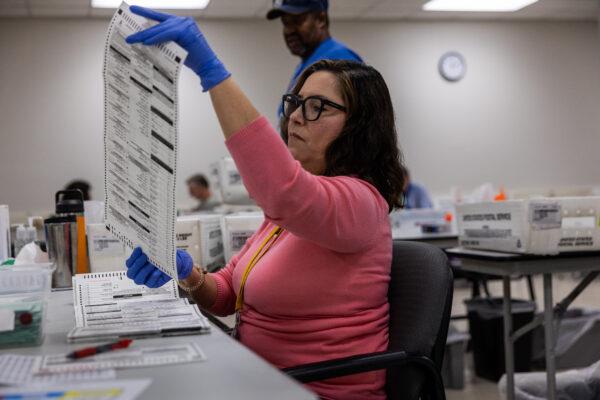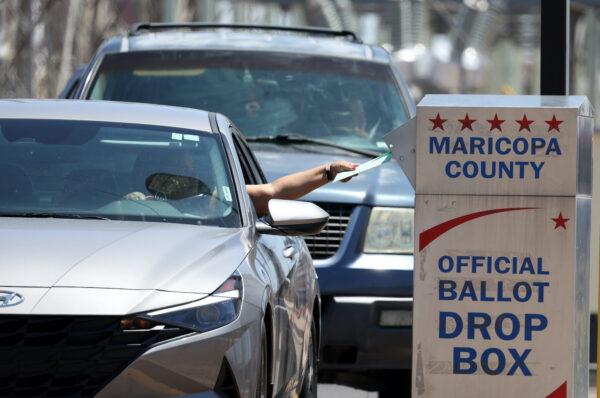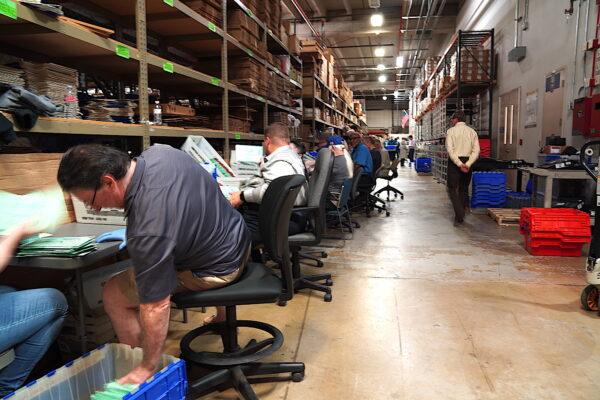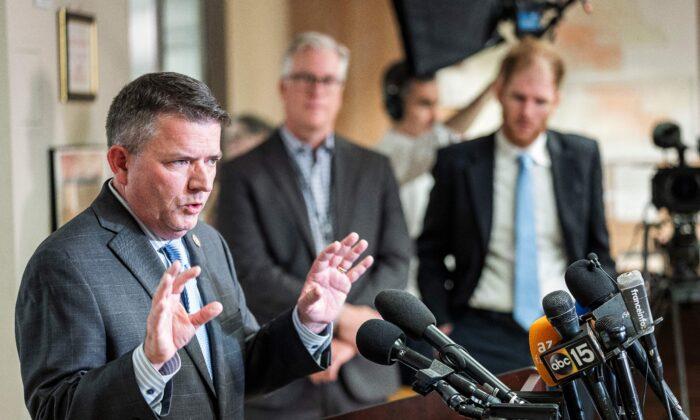In a newly released report, independent investigators have concluded that a slew of ballot-on-demand printer failures in the Nov. 8, 2022, general election in Arizona’s largest county resulted from equipment malfunction, not human error.
The Maricopa County Attorney’s Office (MCAO) hired former Arizona Supreme Court Chief Justice Ruth McGregor, a Republican, to lead the investigation to determine what caused so many printers to fail in the general election, determine why they performed without problems in previous elections, and suggest solutions to prevent future issues.
“The MCAO made it clear at the outset that this investigation should be independent and free of any outside influence,” McGregor wrote.
Maricopa County Board of Supervisors Chairman Clint Hickman said he called for an outside investigation of reports of ballot printers malfunctioning “as soon as this happened.”

In a statement, Hickman said, “We don’t grade our own homework, and now that we have a better idea of the factors involved, we'll make changes to serve voters best, starting with replacing some equipment.”
Over two months, McGregor’s team looked at reports of printer malfunctions that affected approximately 60 vote centers in Maricopa County, resulting in long lines of frustrated voters and cries of voter disenfranchisement.
The report concludes that no one could have predicted the widespread printer problems, given that the 2022 August primary election went mainly without a hitch.
“Any failure in the process or human error relates to a failure to anticipate and prepare for the printer failures experienced. But nothing we learned in our interviews or document reviews gave any clear indication that the problems should have been anticipated,” McGregor wrote in the 38-page report.
“Most of the printers had been used during the August 2022 primary election, as well as prior elections, without experiencing similar problems.”
During February and March, McGregor’s investigators printed and counted 9,100 ballots on randomly chosen printers and tabulators—and interviewed county and Runbeck Election Services employees who used the printers—and experts in election procedures.
Printers Not up to Task
McGregor wrote that the combination of the 100-pound weight ballot paper and a 20-inch ballot during the 2022 general election pushed the county’s Oki B432 printers to the limit of their capacity, which could “not be sustained by a substantial number of printers.”During the 2022 primary, Maricopa County used the retrofitted Oki B432 and Lexmark C4150 ballot-on-demand printers at county vote centers. The printers used the same settings in the 2022 election.
County election officials also increased the ballot length from 19 inches to 20 inches because of the many candidates and propositions that couldn’t fit on the smaller ballot.
Still, according to the report, the county conducted extensive “stress tests” on the ballot printers and found no issues. The county assigned 591 printers for 223 vote centers during the 2022 general election.

The report states that Maricopa County made technical changes between the 2020 and 2022 primary and general elections that “could have affected the performance of the printers.”
Almost immediately, on the morning of the general election, Maricopa County Tabulation and Election Center (MCTEC) in Phoenix began receiving calls from precinct vote centers that many tabulators wouldn’t accept ballots.
Those ballots were set aside in a secure box for later tabulation at MCTEC.
“At the outset, Maricopa County and Runbeck identified the cause of the reported problem as being either the on-site tabulator or the [ballot-on-demand] printers,” the report reads.
The county concluded that several older printers couldn’t maintain heat sufficient to print ballots dark enough to be read by the tabulators. The report appears to corroborate that finding.
Machine Failure ‘Unacceptable’
“Whether it’s replacing printers, using different paper, or changing the way we test equipment before an election, you can be sure our board will take any steps necessary to ensure in-person voters have the experience they deserve in 2024,” Sellers said.supervisor Thomas Galvin said, “I’m grateful for Justice McGregor’s exhaustive investigative report.
“I have always maintained that these failures were unacceptable, and we needed to address them and work on improvements.

“This report lays out how equipment failures were the main cause of the problems on Election Day. This report also notes how procedural matters should be bolstered to increase the likelihood of catching potential problems.
“I welcome and agree with that assessment. There are other potential policy solutions identified in the report that I believe are worth considering and discussing.”
The report recommends replacing the Oki B435 printers as a remedy, switching to a higher paper weight for print ballots, and better stress tests at intervals before elections.
“Continuous improvement is what we do at Maricopa County, so I welcome this report,” Supervisor Bill Gates said.
“It shows that two things can be true at the same time: Our elections team prepared well for the 2022 General Election and had every reason to trust our procedures and equipment. And yet, we can do better knowing what we know now.”
Supervisor Steve Gallardo said, “No election is perfect; there are so many factors involved.
“But that’s why you do post-election analysis—what went right, what went wrong—and then you fix what needs to be fixed.
“When it comes to these printer issues, we’re going to do that, believe me.”
Always ‘Human Error’
Although he hadn’t seen the report, Nguyen said: “It’s extremely poor not to have those [technology] things prepared to work when discussing elections. It’s strange for me to absorb that.“When you have broken or incorrectly selected machines, it is human error. If you select the wrong technology for the wrong paper, it is human fault. There’s no way around that.
“We’re talking elections for the nation.”

Following the Nov. 8 election, Republican gubernatorial candidate Kari Lake filed a lawsuit challenging the election results and citing widespread voter disenfranchisement due to ballot printer failure across the system.
Before the election, Lake—endorsed by former President Donald Trump—was ahead of her Democratic opponent Katie Hobbs by 11 percentage points in several polls.
She’s pursuing legal action through Arizona’s Supreme Court as she weighs a possible run for U.S. Senate.
On April 11, Lake questioned the findings contained in the McGregor report, saying they contradicted expert testimony that the machines’ failure wasn’t accidental.
“The conclusions drawn by Maricopa County’s internal investigation are in complete contrast to expert testimony, and anyone with knowledge of the machines will attest to just that,” Lake said in a prepared statement.
“The fact that Maricopa County ran a ‘private test’ using taxpayer money and not inviting impartial evaluators or members of my team shows just how unserious their ‘investigation’ was.
“The notion that Maricopa County printers, across 61 percent of all locations, would have simultaneously decided to print out the wrong-sized image on the ballots, independent of human intervention, is absurd.
“These machines didn’t suddenly decide to gain their settings and that’s exactly what happened on Nov. 8, 2022.”
Lake said that she'll “continue to fight until the truth comes out, even if that means bringing [the] case to the U.S. Supreme Court.”





